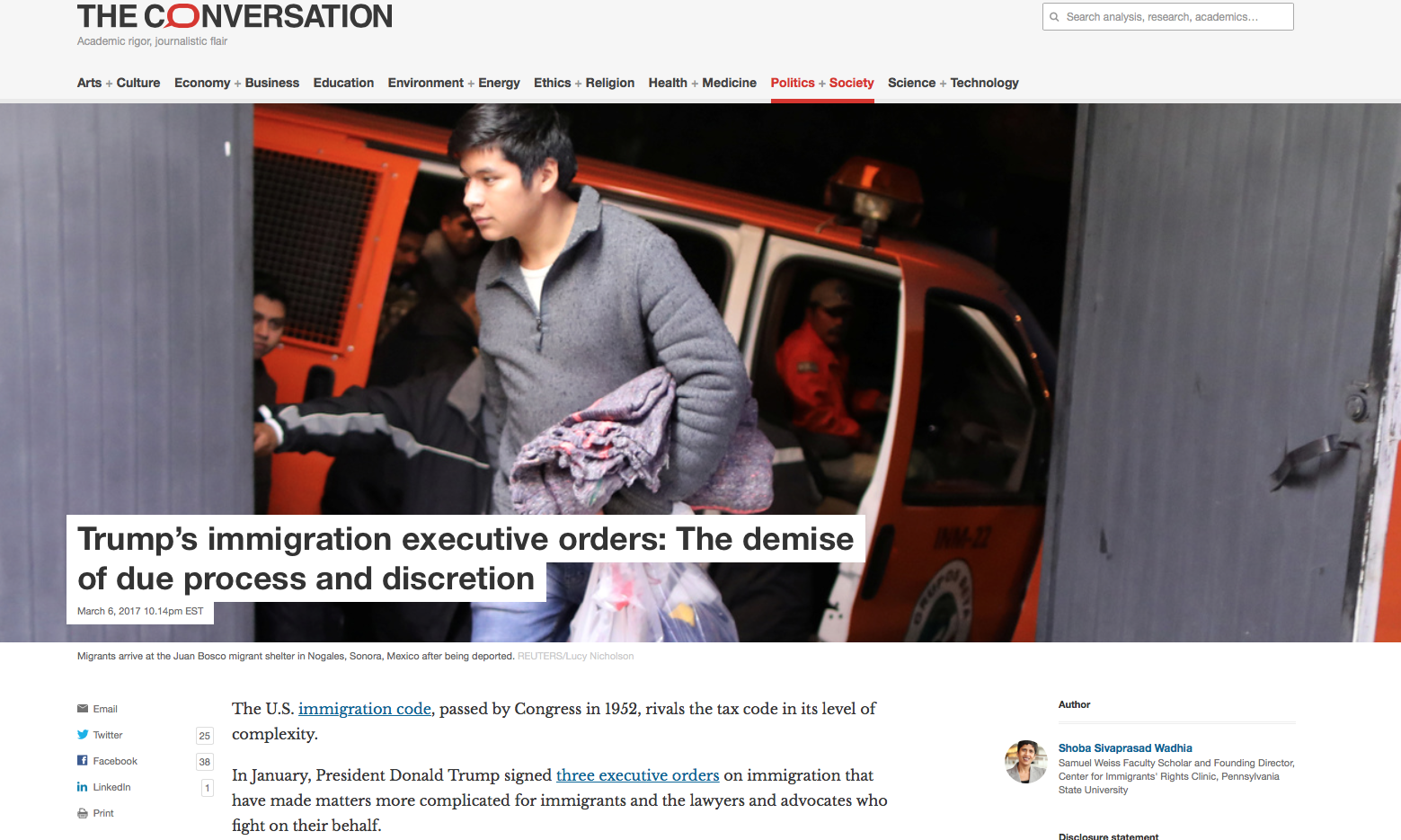By Shoba Sivaprasad Wadhia | Samuel Weiss Faculty Scholar and Founding Director of the Center for Immigrants’ Rights Clinic
The U.S. immigration code, passed by Congress in 1952, rivals the tax code in its level of complexity. ![]()
In January, President Donald Trump signed three executive orders on immigration that have made matters more complicated for immigrants and the lawyers and advocates who fight on their behalf.
As an immigration lawyer and teacher, I have spent countless hours helping those in need and educating my community, which includes residents, educators, professors, international students and scholars, along with local government about the contents of the orders, and the guidelines released by the Department of Homeland Security in February and how they will be implemented.
Specifically, the two orders on deportations and enforcement, both signed on Jan. 25, reveal that the government is making three major changes.
First, the orders are making virtually every undocumented person a priority for deportation.
Second, they seek to maximize existing programs that allow deportation of individuals without basic due process. This includes the right to be heard by a judge, present evidence or challenge a charge of deportation.
And third, pursuant to its Feb. 20 memorandum, DHS has rescinded most documents that offered guidance on prosecutorial discretion.
Prosecutorial discretion in immigration law refers to the choice made by a government official or agency to enforce or not enforce the immigration law against a person. It has been the central focus of my research, and is a critical component in our immigration system. Officials must choose whom to prioritize for removal because they have limited resources. The government has also recognized other compelling reasons why a person might deserve to not be deported. For example, a person without papers who has lived in the United States for several years and has family ties, steady employment or community leadership may temporarily be protected from removal.
Do Trump’s executive orders signal an end to this practice?
Everyone is a priority
DHS has rescinded the 2014 Johnson Priorities Memo, which provided a framework for determining who is a priority for immigration enforcement and articulated the factors that should be considered when making decisions about whether to deport someone.
For example, the memo instructed DHS to consider amount of time spent living in the United States and “compelling humanitarian factors such as poor health, age, pregnancy, a young child, or a seriously ill relative.”
Now, the government is taking a hard-line approach to immigration enforcement, without explicit consideration for a person’s circumstances. The orders list specific parts of the 1952 immigration statute that target those eligible for deportation for reasons related to crimes or misrepresentation. But enforcement officials will also now target deportable immigrants who:
- have been convicted of any criminal offense;
- have been charged with any criminal offense that has not been resolved;
- have committed acts that constitute a chargeable criminal offense;
- have engaged in fraud or willful misrepresentation in connection with any official matter before a governmental agency;
- have abused any program related to receipt of public benefits;
- are subject to a final order of removal but have not complied with their legal obligation to depart the United States; or
- in the judgment of an immigration officer, otherwise pose a risk to public safety or national security.
DHS guidance does not stop with this priority list. It goes on to suggest that any person without documents might be a priority. It repeatedly states: “All of those in violation of the immigration laws may be subject to immigration arrest, detention and, if found removable by final order, removal from the United States.”
Arguably, an undocumented parent living in the United States for several years and taking care of children who have formal or permanent immigration status, or United States citizenship, could be targeted as a person “in violation of the immigration laws,” whereas before this same person would have more clearly been eligible for prosecutorial discretion and not been labeled as a priority. Similarly, a student who overstays her visa and then jaywalks may be treated as an enforcement priority because jaywalking constitutes a chargeable offense.
The cumulative effect is fear that everyone is a priority.
Despite major changes to enforcement, the guidance from DHS suggests that individual prosecutorial discretion may be exercised on a case-by-case basis, and preserves three policies relating to enforcement.
One pertains to “sensitive locations” and instructs DHS to avoid enforcement in places like schools, places of worship and hospitals.
The second is a guideline on granting parole to certain arriving asylum seekers after a “credible fear” interview has been conducted. When an asylum seeker is “paroled,” she is released from detention and able to pursue her asylum claim outside of custody.
The final memo that is still intact is the Deferred Action for Childhood Arrivals. DACA enables qualifying noncitizens who entered the United States at a young age, often referred to as “Dreamers,” to apply for protection from deportation and work authorization.
While I see the preservation of these guidelines as positive, the overriding message of the executive orders and implementation memos is one of speedy enforcement without discretion or due process.
Shoba Sivaprasad Wadhia is the Samuel Weiss Faculty Scholar and founding director of the Center for Immigrants’ Rights Clinic at Pennsylvania State University. This article was originally published on The Conversation. Read the original article.









